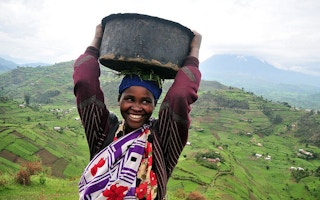In recent years, Olam has made extensive progress under its Livelihood Charter, which was launched in 2010 and aims to support smallholders in our supply chain.
But smallholder productivity across Africa, Asia and South America will still be massively hindered by a lack of access to finance, gender equality and climate change impacts. Far greater collaboration and knowledge sharing across agricultural supply chains is needed to address this.
Smallholders grow globally consumed crops such as cocoa, coffee and cashew and if they don’t see farming as a viable livelihood then they will seek other work, typically in cities.
Since we launched the Olam Livelihood Charter (OLC) 5 years ago, we’ve gone from supporting 64,290 smallholders to just under 345,000, accounting for 23 per cent of our 2015 smallholder procurement.
Thanks to our teams ensuring all eight OLC Principles - namely, finance, improved yield, labour practices, market access, quality, traceability, social and infrastructure investment, and environmental impact - are applied, together with the support of our non-government organisation, customer and finance partners, we are definitely seeing yields, quality and income improve. This shows that OLC works as a business model.
However, even five years on, there is more to be done.
Where access to finance is concerned, innovation in mobile payments and banking services has improved. But limited rural banking infrastructure and lack of credit history still severely restricts farmers and their ability to buy agricultural inputs like fertiliser, hire labour, or invest.
Even when lenders are present, banks are risk averse and informal lenders charge high rates, leaving a finance gap in the agricultural sector.
In 2015 Olam provided over US$177 million in finance to cocoa, coffee, cashew, cotton, chilli, hazelnut, rice, sugar and sesame farmers.
By 2020 our aim is to support about 500,000 smallholders across 1 million hectares under the OLC, but there are millions more who need support. We have identified another five key learnings to share with others in the field who may be facing similar challenges.
We have to navigate local customs sensitively to empower women
Evidence shows that for every US$1 earned, a woman will invest 90 cents in her family and community, compared to 35 cents for men. However, some traditions do not permit women to own farms, speak in meetings or even be present at training.
Encouraging chiefs to permit and welcome women’s participation can be a slow process, and one that has to be based on mutual trust and respect. Last year, we achieved a 6 per cent increase in female farmers under the OLC to reach 67,708.
Smallholders need to be equipped to deal with climate change now
When the OLC started, environmental training focused on protecting water bodies, preventing deforestation and safe pesticide use. But as the reality of climate change reaches farming communities, so has the urgency of mitigating impacts.
Training farmers in climate smart agriculture (CSA) is essential to resilient rural livelihoods and it is firmly on the agenda across OLC projects in at-risk zones. In 2015 this training reached about 60,000 farmers managing 110,000 hectares of cocoa, coffee, cotton, cashew, sugar and black pepper.
“
But smallholder productivity across Africa, Asia and South America will still be massively hindered by a lack of access to finance, gender equality and climate change impacts.
Training needs to go beyond the classroom with financial reassurance
Although we are seeing increased yields thanks to training, achieving behaviour change on the ground takes time. Farmers have to put their faith in advice that may be contrary to generations of tradition, or they may not be willing to take what appears to be a financial risk.
Pruning is a good example: while it will help the tree to flourish in the future, a cocoa farmer may choose not to risk losing branches that may have yielded even a small number of pods in the past.
This is why longer-term financing while the tree rejuvenates is important, as is establishing more model farms and demo plots to run alongside group and one-to-one training. We set up 1,816 demonstration plots in 2015, an 89 per cent increase from 2014, and also trained 254,146 farmers last year.
We can’t just focus on cash crops – farmers need to grow a balanced diet
Most agricultural training focuses on increasing the productivity of income-earners rather than stomach-fillers but food security is vital for farmer well-being.
In 2015, the OLC cotton initiative in Côte d’Ivoire formalised its approach. The team delivered training on improved nutrition to 4,000 farmers, provided US$2 million worth of inputs such as fertiliser for staple food crops like rice, and launched ‘Project Maize’, which saw farmers more than double their yields as a result of new varieties of maize that were distributed.
Tech is a game changer
Technological advances will drastically benefit both farmers and customers in ways we have not yet foreseen. Already, the application of GPS mapping, big data and online systems has made significant leaps in traceability and our ability to tailor advice down to individual farm management plans.
Until now, the data from remote smallholder farms has either been completely inaccessible or has required manual collection and collation. Now, information, including agricultural practices, production inputs, finances, yields and GPS data, is recorded and analysed centrally through the Olam Farmer Information System (OFIS) developed by Olam Cocoa.
Tens of thousands of cocoa, coffee and rubber farmers have already registered, and the platform will be rolled out to other products over 2016 and 2017 enabling more effective intervention.
To read more about Olam’s overall approach to growing responsibly, the 2015 Corporate Responsibility and Sustainability Report is available as a ‘deep dive’ web report with downloadable pdf and as an Executive Summary.
Chris Brett is the Global Head Corporate Responsibility & Sustainability at Olam International. This article was written exclusively for Eco-Business.











